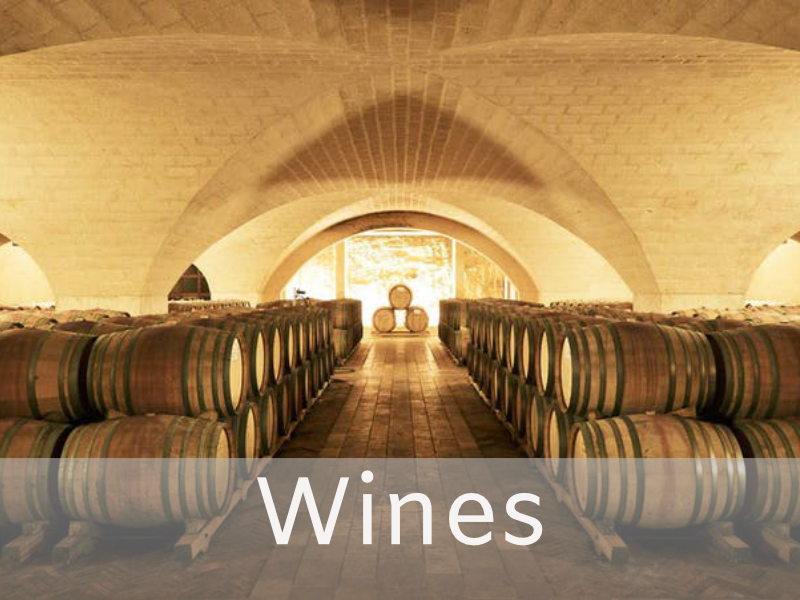Puglia Routes
With its 280 miles in length, Apulia has a very varied territory that offers diversified cycling experiences suitable for satisfying different skill levels. The common denominator, we ride in rural areas with little traffic with beautiful landscapes that cross ancient towns that preserve important historical/artistic heritage.
We are at the very South end of Italian peninsula where the Apennine mountain range that draws the backbone of the boot (shape of Italy), ends up in the sea.
We start from the Murgia Highland and arrives at on Salento Peninsula passing through, the Small Lucanian Dolomites and the Trulli Valley. The rides touch five of the six UNESCO World Heritage Sites of Apulia.
What does the holiday in Apulia reserve? Beautiful rides on roads with very little traffic in still wild areas, excellent regional cuisine, beautiful cities with a lot of history, a lively nightlife and splendid beaches with crystal clear sea.
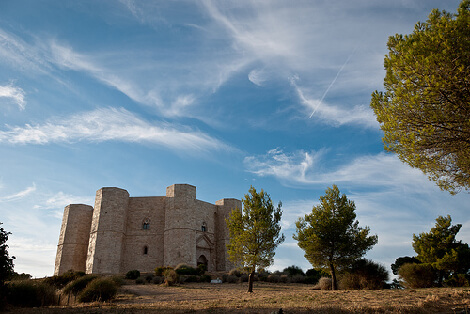
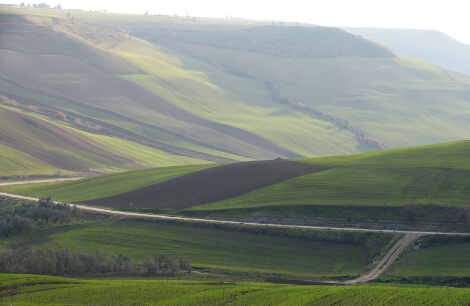
MURGIA HIGHLAND
These are the places loved by Emperor Frederick II of Swabia (13th century), it is here that the emperor loved to hunt and it is here that he wrote: “De artevenandi cum avibus” (On the art of hunting with birds). Even today it is not at all difficult to see several breeds of birds of prey in flight that in the Middle Ages were used to hunt.
The Murgia is an extensive karst plateau of tectonic origin that includes part of the Apulia and Basilicata regions. It is a hilly area with elevations up to 2000 feet above sea level. Typical features of the landscape are the «Gravine», karst erosions comparable to canyons, with steep and deep walls even more than 800 feet.
We will ride across this wide plateau following the ancient sheep tracks of the transhumance, the roads used by the shepherds to bring the flocks to pasture.
The Murge Highland door is the majestic Castel del Monte (13th century), built as part of his network of strategically placed defensive castles. Famous for its mysterious and unique shape, it was built in an octagonal shape, with each of the eight corners sporting an octagonal tower, the castle was declared World Heritage by UNESCO in 1996, and it is one of the best-preserved medieval castles in Southern Italy.
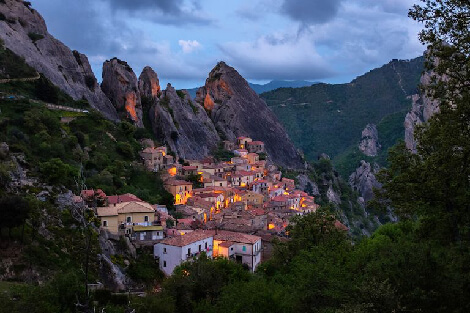
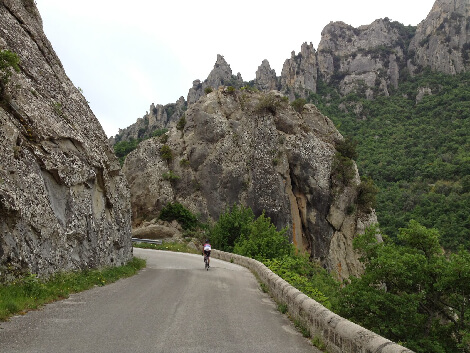
SMALL LUCANIAN DOLOMITES
They are called Piccole Dolomiti for the similarity with the most famous Dolomites of the Alps, they are the terminal part of the Apennines Mountain.
The erosion over the centuries has formed steep peaks and sharp Spiers, reaching up to 5000 feet above sea level.
The inhabitants called the particular shapes of the rocks with names such as the golden eagle, the anvil, the great mother, the owl.
The environment is made up of large forests and in the highest part of rocks, by bicycle, you can travel on routes with little traffic which in relation to length can also become very challenging.
Let’s not forget Matera, the Lucania capital, the incredible city of the “Sassi”, moving to Matera is like living in a forgotten past, the feeling is that of entering a crib.
In 1993 UNESCO included the “Sassi” of Matera in the list of world heritage, with the motivation “a model of life in balance with the environment, with which it integrates without distorting it while exploiting its resources”.
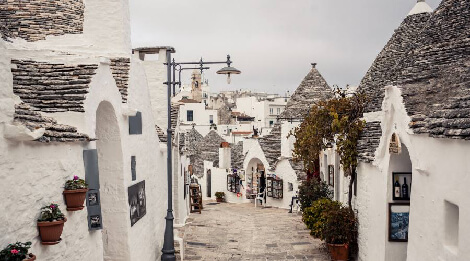
TRULLI VALLEY
Welcome to the Valle of Trulli, you go from the wild rural landscapes of the Murge to the Valle d’Itria, where the outcome of the wise integration between the anthropic components of the towns and the natural part of the countryside is singular and recognizable. Human activities (agricultural and settlement) have adapted to the structure and shape of the places, favoring the roughness of the karst soil. Unparalleled expanses of olive trees, trees born from the fragrant red earth, make the panorama of this area a succession of wonderful chromatic effects. It may be due to the white of the houses or the green vegetation that frames them, but every village, every village in the valley, is surrounded by a magical, almost fairytale atmosphere. Crossing this area means passing from one town to another and breathing the millenary culture and history preserved by these places, each town encountered is different in culture and traditions, we describe some of them:
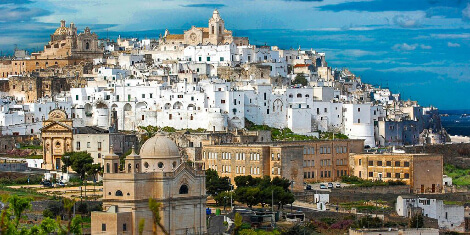
Ostuni – The White CityOstuni, also known as the White City for its historic center painted with white lime, is positioned on a defensive balcony which dominates the coast of the Adriatic coast.
The territory was inhabited since prehistoric times. it was a Greek colony, later occupied by the Lombards, Saracens, and Normans, so much so that it became one of the dominant cities in the area.
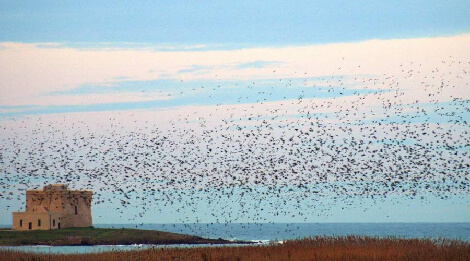
Cisternino – The Fornello Pronto town
In the heart of the valley of the Trulli (typical rural construction with conical stone roof) it is part of the white Apulian cities, of medieval origin, has a historic center full of charming alleys with arches of narrow streets, squares with balconies surrounded by greenery and small courtyards . A city with a very lively life is the capital of the Fornello Pronto, described below.
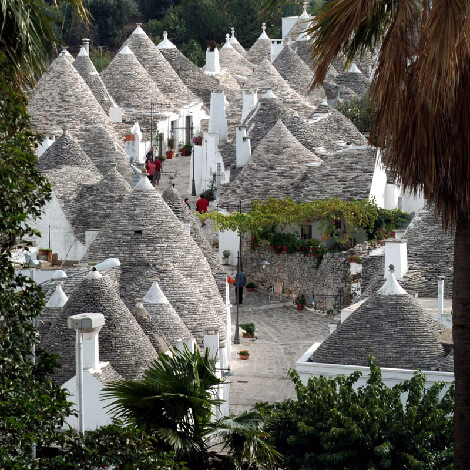
Alberobello – The City of Trulli Known as the city of the Trulli, traditional rural dry stone houses whitewashed with quicklime and covered with conical bare stone roofs, Alberobello is another of the UNESCO World Heritage Sites in Puglia.
The historic center is entirely composed of Trulli, with their roofs decorated with crosses, pierced hearts, zodiac signs, the most important neighborhood is Rione Monti, a labyrinth of winding streets with over 1,000 Trulli.
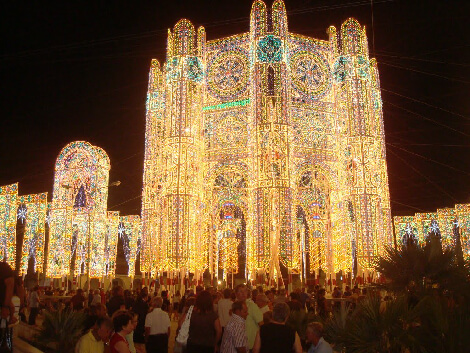
SALENTO PENINSULA
We are at the end of the earth and the journey, beyond there, is only the sea. Salento the last land, isolated for centuries and sparsely inhabited due to the Turkish invasions from the sea, has kept its nature, its sea, and its genuine folklore intact. It boasts the most beautiful coasts of the Mediterranean, alternating beaches with fine golden sand with high and jagged rocks incredible for their rough and archaic beauty.
It is a largely agricultural area surrounded by luxuriant vegetation where olive trees, vineyards, citrus trees, shady pine forests near the sea, and prickly pears that characterize the whole Mediterranean grow.
Along the entire length of the coast, you can meet the Coastal Watchtowers, built starting from the 16th century to defend the population from attacks by the Turks and pirates.
The White Cities of the Salento territory preserve the gastronomic and cultural traditions transmitted for generations which today are the best showcase of this territory.
Do not miss the celebration of the patron saint. In summer every village or city organizes these typical festivals setting up of the Illuminations. The illuminations are luminous structures that mimic the baroque architecture of the cathedrals of Salento. They are lit when oxen are made and they create real magic.
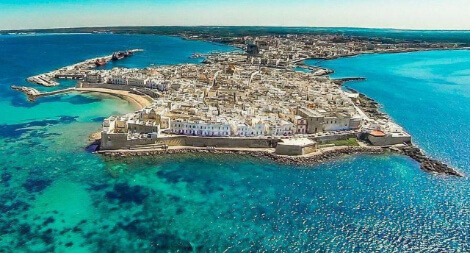
Gallipoli – The military fortress on the sea The meaning of the name Gallipoli is Beautiful Town. Located on the Ionian Sea, it is famous as a tourist place for its beaches.
The Old Town, the historical core, is located on a small island connected to the mainland by a bridge built in the 16th century, it is almost completely surrounded by defensive walls, built mainly in the 14th century.
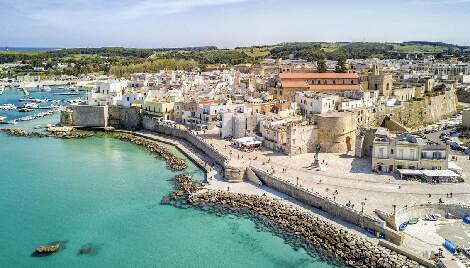
Otranto – A Bridge Between The West And The East
It is an ancient fortified city, the easternmost of Italy, called the city of martyrs. It is the true jewel of Salento, culturally a bridge between West and East, a place rich in history, art, culture, it is also one of the most beautiful summer destinations.
The city is a destination for intense tourism and is characterized by the following monuments:
The Aragonese Castle, an ancient military fortress (15th century), the Borgo Vecchio, the ancient nucleus of the city, a labyrinth of alleys and squares, shops and restaurants, the Cathedral (11th century) which presents a stratification of Byzantine, early Christian and Romanesque architectural styles, is famous for the large mosaic of the floor of Tree of life, trace the human experience from original sin to salvation.
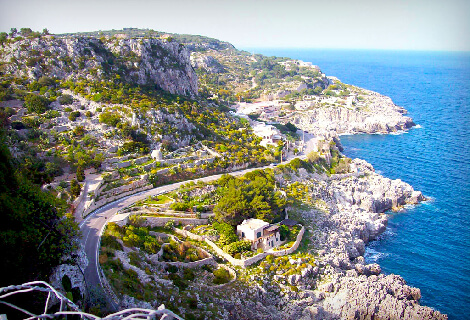
Santa Maria di Leuca – The Finibus Terrae“Finibus Terrae” (the end of the earth) is the definition of the ancient Latins, the territory that marks the end of the boot, overlooks the Mediterranean, looks beyond Italian borders as an approach with neighboring peoples. This geographical position has represented, over the centuries, an opportunity for meeting, aggregation, mixing between peoples and cultures of the Mediterranean basin: in Leuca there are signs of the passage of Cretans, Phoenicians, Greeks who found the port here for the maritime traffic, the meeting point between the commercial lines that joined East and West.
Legend has it that the name Leuca derives from a beautiful mermaid, called “Leucasia”, who enchanted the sailors with sweet melodies, the place where Ulysses (Odyssey) meets the sirens is not far from here.



